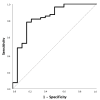Bioelectrical Impedance Analysis Demonstrates Reliable Agreement with Dual-Energy X-ray Absorptiometry in Identifying Reduced Skeletal Muscle Mass in Patients with Metabolic Dysfunction-Associated Steatotic Liver Disease and Hypertension
- PMID: 39451624
- PMCID: PMC11507167
- DOI: 10.3390/diagnostics14202301
Bioelectrical Impedance Analysis Demonstrates Reliable Agreement with Dual-Energy X-ray Absorptiometry in Identifying Reduced Skeletal Muscle Mass in Patients with Metabolic Dysfunction-Associated Steatotic Liver Disease and Hypertension
Abstract
Background/Objectives: Body composition (BC) affects the risk of developing metabolic dysfunction-associated steatotic liver disease (MASLD) and hypertension (HTN). Currently, dual-energy X-ray absorptiometry (DEXA) is considered the gold standard for assessing BC, even though it has some limitations, including immobility, ionizing radiation, and patient weight restrictions. The aim of the study was to evaluate the correlations of BC parameters measured by bioelectrical impedance analysis (BIA) with those measured by DEXA in patients with MASLD and HTN. Methods: Overall, 78 patients with MASLD and HTN underwent the following study procedures: compilation of an anamnesis, physical examination of a patient, laboratory tests, abdominal ultrasound, BIA, DEXA, and anthropometric measurements. Results: The agreement between BIA and DEXA in diagnosing reduced skeletal muscle mass (SMM) in patients with MASLD and HTN was moderate (kappa values were 0.440 and 0.404 in males and females, respectively). Significant strong direct correlations were found between fat mass (FM) and body fat percentage measured by BIA with corresponding measurements by DEXA (p < 0.001 for both). The area under the receiver operating characteristic curves (AUC) of SMM to body weight ratios calculated using BIA data were 0.834 and 0.929 for reduced appendicular SMM determined by DEXA in males and females with MASLD and HTN, respectively. Conclusions: In conclusion, BIA is an easy-to-use and widely available tool for assessing SMM and FM in patients with MASLD and HTN, demonstrating reliable agreement with DEXA measurement results and completely free of its limitations.
Keywords: body composition; fat mass; hypertension; metabolic dysfunction-associated steatotic liver disease; skeletal muscle mass.
Conflict of interest statement
The authors declare no conflicts of interest.
Figures


References
-
- Eguchi Y., Hyogo H., Ono M., Mizuta T., Ono N., Fujimoto K., Chayama K., Saibara T., JSG-NAFLD Prevalence and Associated Metabolic Factors of Nonalcoholic Fatty Liver Disease in the General Population from 2009 to 2010 in Japan: A Multicenter Large Retrospective Study. J. Gastroenterol. 2012;47:586–595. doi: 10.1007/s00535-012-0533-z. - DOI - PubMed
-
- Younossi Z., Aggarwal P., Shrestha I., Fernandes J., Johansen P., Augusto M., Nair S. The Burden of Non-Alcoholic Steatohepatitis: A Systematic Review of Health-Related Quality of Life and Patient-Reported Outcomes. JHEP Rep. Innov. Hepatol. 2022;4:100525. doi: 10.1016/j.jhepr.2022.100525. - DOI - PMC - PubMed
-
- Duell P.B., Welty F.K., Miller M., Chait A., Hammond G., Ahmad Z., Cohen D.E., Horton J.D., Pressman G.S., Toth P.P., et al. Nonalcoholic Fatty Liver Disease and Cardiovascular Risk: A Scientific Statement from the American Heart Association. Arterioscler. Thromb. Vasc. Biol. 2022;42:e168–e185. doi: 10.1161/ATV.0000000000000153. - DOI - PubMed
Grants and funding
LinkOut - more resources
Full Text Sources

